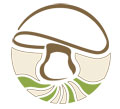Itchen Wood, Northington
Sat 30 Aug 2014
Field event ID HF1412
OS Grid areas: SU5336
Weather: Heavy rain over previous week after prolonged dry period.
New Records:
New to Hampshire: Botryobasidium laeve
Report: Despite the fact that the BMS Scottish foray was detaining some of the regulars, the damp weather encouraged a good attendance and when they set off, the forayers were quite optimistic. However, the first thing we noticed were the large number of slugs prowling the undergrowth in search of any emerging fruit body. They didn't seem to be interested in Mycena pelianthina, which was present in good numbers but other agarics were in very short supply throughout the beech woodland. In contrast, almost every log had a resupinate on its underside and Paul was soon threatening to leave early as his boxes were overflowing. Despite the limited number of fruit bodies, the range of species was quite high for the time of year, possibly reflecting the range of habitats. Worthy of note were some &ldquo:LBJs”, which turned out to be Inocybe petiginosa and the bright orange Cordiceps militaris, of which several were found in the Beech woodland - does this reflect an infestation, or just that the habitat is a suitable pupating site for their hosts? It is always helpful to find pairs of look-a-likes to allow their distinguishing features to be contrasted. We also found two such pairs; the "chunky" Xylaria polymorpha and its spindly cousin X. longipes and the common, hard-topped, Ganoderma australe with the less frequent, softer G. applanatum. Both pairs can also be distinguished by spore size but they can be separated in the field. Paul's large haul contained the rare Botryobasidium laeve (fka as B. pruinatum var laeve). Is this the start of a fruitful season, or will an indian summer desiccate everything again? WTS…
Species list: Agaricus moelleri, Amanita vaginata, Auricularia auricula-judae, Biscogniauxia nummularia, Bjerkandera adusta, Boletus pruinatus, Botryobasidium aureum, Botryobasidium laeve, Botryobasidium subcoronatum, Calocera viscosa, Ceratiomyxa fruticulosa var. fruticulosa, Ceriporiopsis pannocincta, Clitocybe gibba, Coprinellus micaceus, Cordyceps militaris, Erysiphe alphitoides, Fuligo septica var. septica, Fuscoporia ferrea, Ganoderma applanatum, Ganoderma australe, Heterobasidion annosum, Hypoxylon fragiforme, Inocybe petiginosa, Laccaria laccata, Lachnum virgineum, Lactarius quietus, Lycoperdon perlatum, Lycoperdon pyriforme, Marasmiellus ramealis, Marasmius rotula, Marasmius wynneae, Megacollybia platyphylla, Melanoleuca polioleuca, Meripilus giganteus, Mycena arcangeliana, Mycena pelianthina, Mycena pura, Panaeolus semiovatus var. semiovatus, Peniophorella praetermissa, Phlebiella sulphurea, Phragmidium violaceum, Physisporinus sanguinolentus, Pluteus cervinus, Pluteus phlebophorus, Psathyrella candolleana, Psathyrella piluliformis, Rhytisma acerinum, Rickenella fibula, Russula grisea, Sawadaea bicornis, Scleroderma citrinum, Scopuloides rimosa, Skeletocutis nivea, Stereum hirsutum, Stereum subtomentosum, Trametes versicolor, Trechispora mollusca, Trochila ilicina, Tubaria furfuracea, Tubulifera arachnoidea, Xerula radicata, Xylaria hypoxylon, Xylaria longipes, Xylaria polymorpha
